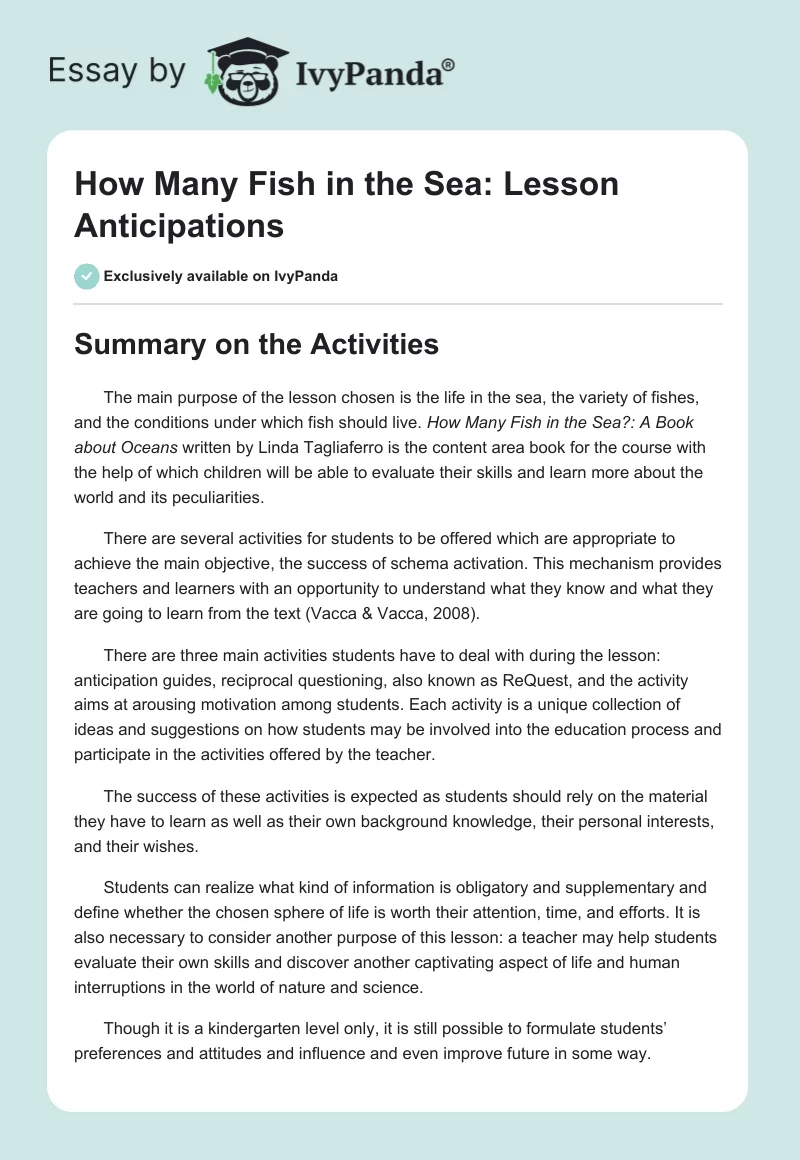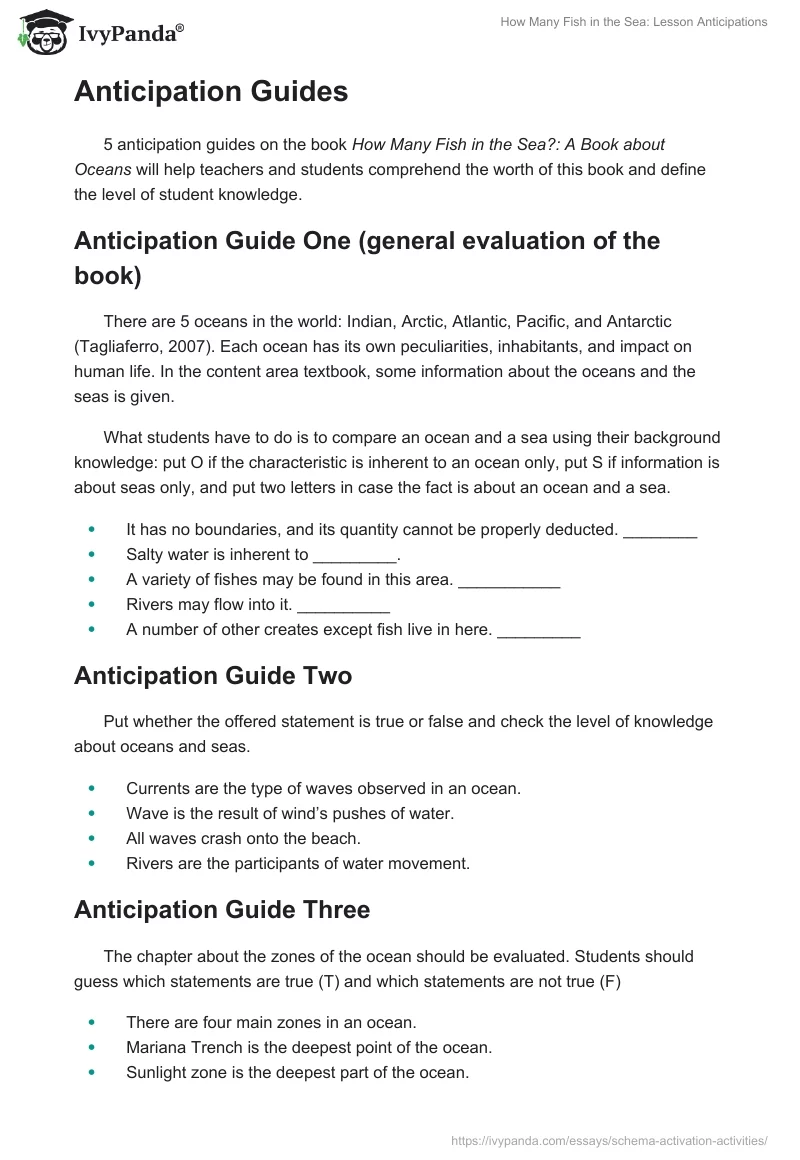Summary on the Activities
The main purpose of the lesson chosen is the life in the sea, the variety of fishes, and the conditions under which fish should live. How Many Fish in the Sea?: A Book about Oceans written by Linda Tagliaferro is the content area book for the course with the help of which children will be able to evaluate their skills and learn more about the world and its peculiarities.
There are several activities for students to be offered which are appropriate to achieve the main objective, the success of schema activation. This mechanism provides teachers and learners with an opportunity to understand what they know and what they are going to learn from the text (Vacca & Vacca, 2008).
There are three main activities students have to deal with during the lesson: anticipation guides, reciprocal questioning, also known as ReQuest, and the activity aims at arousing motivation among students. Each activity is a unique collection of ideas and suggestions on how students may be involved into the education process and participate in the activities offered by the teacher.
The success of these activities is expected as students should rely on the material they have to learn as well as their own background knowledge, their personal interests, and their wishes.
Students can realize what kind of information is obligatory and supplementary and define whether the chosen sphere of life is worth their attention, time, and efforts. It is also necessary to consider another purpose of this lesson: a teacher may help students evaluate their own skills and discover another captivating aspect of life and human interruptions in the world of nature and science.
Though it is a kindergarten level only, it is still possible to formulate students’ preferences and attitudes and influence and even improve future in some way.
Anticipation Guides
5 anticipation guides on the book How Many Fish in the Sea?: A Book about Oceans will help teachers and students comprehend the worth of this book and define the level of student knowledge.
Anticipation Guide One (general evaluation of the book)
There are 5 oceans in the world: Indian, Arctic, Atlantic, Pacific, and Antarctic (Tagliaferro, 2007). Each ocean has its own peculiarities, inhabitants, and impact on human life. In the content area textbook, some information about the oceans and the seas is given.
What students have to do is to compare an ocean and a sea using their background knowledge: put O if the characteristic is inherent to an ocean only, put S if information is about seas only, and put two letters in case the fact is about an ocean and a sea.
- It has no boundaries, and its quantity cannot be properly deducted. ________
- Salty water is inherent to _________.
- A variety of fishes may be found in this area. ___________
- Rivers may flow into it. __________
- A number of other creates except fish live in here. _________
Anticipation Guide Two
Put whether the offered statement is true or false and check the level of knowledge about oceans and seas.
- Currents are the type of waves observed in an ocean.
- Wave is the result of wind’s pushes of water.
- All waves crash onto the beach.
- Rivers are the participants of water movement.
Anticipation Guide Three
The chapter about the zones of the ocean should be evaluated. Students should guess which statements are true (T) and which statements are not true (F)
- There are four main zones in an ocean.
- Mariana Trench is the deepest point of the ocean.
- Sunlight zone is the deepest part of the ocean.
- People are able to use the twilight zone only for their activities.
Anticipation Guide Four
The following names are the names of the oceans and seas, and students have to define where the sea’s name (S) is and where the ocean’s name (O) is.
- Caribbean
- Red
- Indian
- Mediterranean
- Atlantic
Anticipation Guide Five
Students have to answer the questions as Likely or Unlikely to demonstrate how deep their knowledge about water world is.
- The ocean floor is similar to a sandy beach.
- Only small mountains may be observed on the ocean’s floor.
- A volcano oozes flowing lava that is rather cold in the ocean.
All these guides are based on particular chapters from the book and may be understood by the students on the kindergarten level. This is why the success of each activity is expected.
Reciprocal Questioning (ReQuest)
Reading research synthesis is an integral part of kindergarten education (Hatch, 2004). This is why it is crucially important to implement “ReQuest” activities to the lesson. In the chosen class, the ReQuest strategy is offered to help students understand the variety of underwater world and living forms which may be observed in here.
- Students and the teacher have to read the same short passage from the book How Many Fish in the Sea?: A Book about Oceans. As it is the kindergarten level, it is possible to provide children with more time to grasp the material and evaluate the pictures provided.
- The teacher has to close the book so that every child sees that there is no attempt to cheat. Students start asking questions about the oceans and seas using the information offered in the book. For example, it is possible to ask a teacher to enumerate the oceans existed. However, a teacher may intentionally omit one ocean so that students could evaluate teacher’s mistake.
- Now, the teacher is going to ask students about the material read. The teacher should focus on some simple questions which may promote student’s imagination. The examples of the questions are as follows: “What is bigger an ocean or a sea?”, “What water is in the oceans?”, and “What kind of ocean does a student want to see? Why?” (It helps to consider the picture and the boundaries the oceans have).
- The same exchange of the roles should take place. The only difference is the chapters which have to be read by the teacher and students. It is possible to read about different zones of the ocean.
- The next stage of the lesson is connected to students’ predictions. The teacher asks students to think about future facts which may be given about the ocean. What kind of information may be offered? What creatures may live in the ocean and in the sea?
- The final activity is the competition between several teams of the class. It is necessary to divide students in the groups of five and make them create the names which are connected to water, oceans, or seas. Then, students have to answer teacher’s questions such as “Which zone is the deepest?”, “What ocean is the biggest on the picture?, etc. All these questions may be discussed before, the main point of this activity is to check how students evaluate the material.
Arousing Curiosity/Motivation
To arouse students’ curiosity, the guided imaginary strategy is offered. At the kindergarten level, students are able to think and develop different situations which meet their interests and needs. What is offered for students is to close their eyes and follow the guidelines by the teacher.
“Imagine that you are a fish (students choose any fish they know) who starts its adventure from the top of the ocean (sea). How does the water smell and taste? You want to share other fishes around what you feel? What is the condition of the ocean (sea)? Are there many waves? How do they move? How do you look like in the ocean (sea)? Which zones of the ocean are the most preferable for you?
What do you on the floor? You cannot resist the ocean that grasps you totally. You enjoy each moment spent under water. You want to move as fast as possible to observe the beauty of water? Share your impressions with other students. Now, it is time to return.
Do you choose the same way? Or do you want to observe some other place? You need to hurry up to enjoy the sunset. You reach the sunlight zone. You are calm. You see the sky. You relax.”
Evaluation of the Model
The project offered in this paper has a number of positive aspects. It helps to improve students’ understanding of personal knowledge and abilities, develop their predicting skills, and imagination.
Cooperation with the teacher is a powerful means that arouse students’ motivation and curiosity: students have to comprehend that other people are already aware of this material, and they should better achieve the same understanding to become equal to the others.
The idea to use ReQuest strategy may be applied as it aims at developing various evaluating skills. And, finally, such strategy as guided imaginary shows how captivating and unpredictable students’ knowledge may be.
Reference List
Hatch, J.A. (2008). Teaching in the New Kindergarten. Clifton Park, NY: Cengage Learning.
Tagliaferro, L. (2007). How Many Fish in the Sea?: A Book about Oceans. Mankato: Capstone Press.
Vacca, R.T. & Vacca, A.J. (2008) Content Area Reading: Literacy and Learning Across the Curriculum. New York: Pearson Education.


